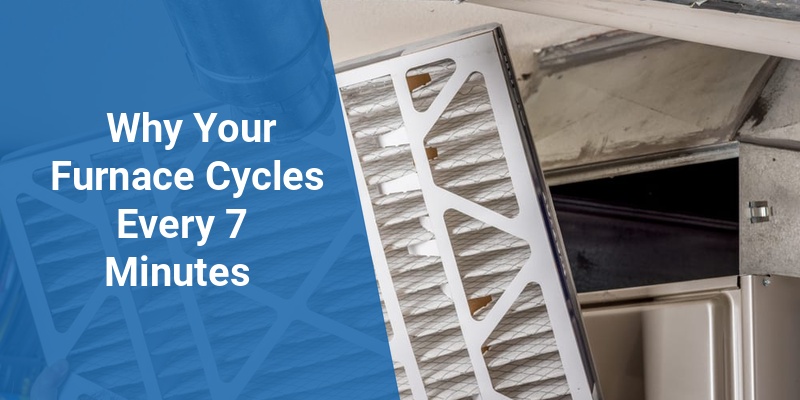Experiencing furnace cycles every 7 minutes can be frustrating and may indicate underlying issues affecting your heating system’s efficiency and longevity. Short cycling, which is when a furnace turns on and off frequently in a brief period, can lead to increased energy bills and potential equipment damage. This article explores the common causes of furnace cycles every 7 minutes and provides practical solutions to help homeowners maintain optimal furnace performance.
| Common Causes | Potential Solutions |
|---|---|
| Dirty Air Filter | Replace or clean the air filter regularly |
| Thermostat Issues | Calibrate or replace thermostat; check placement |
| Oversized Furnace | Consult a professional for proper sizing or adjustments |
| Blocked Vents or Ducts | Inspect and clear vents and ducts |
| Flame Sensor Problems | Clean or replace the flame sensor |
| Short Cycling due to Safety Features | Check for overheating and address causes like blocked airflow |
Understanding Furnace Short Cycling Every 7 Minutes
Furnace short cycling refers to the furnace frequently turning on and off in short intervals, typically less than 10 minutes per cycle. When the furnace cycles every 7 minutes, it often means the heating system is struggling to maintain the desired temperature or is encountering safety interruptions. Short cycling reduces heating efficiency, increases wear and tear, and results in uneven home temperatures.
This behavior is generally a signal that the furnace or its components are not operating optimally and requires investigation to prevent further issues, such as increased utility bills and premature furnace failure.
Common Causes of Furnace Cycling Every 7 Minutes
Dirty or Clogged Air Filter
A blocked air filter is one of the most frequent causes of short cycling. When airflow is restricted, the furnace can overheat quickly, triggering the high-limit safety switch to shut the system off to prevent damage. This causes the furnace to cycle on and off in rapid succession.
Replacing or cleaning the air filter every 1 to 3 months depending on the furnace type and usage can help maintain steady airflow and prevent short cycling.
Thermostat Malfunctions or Poor Placement
An inaccurate thermostat reading or improper placement can cause short cycling. For example, if a thermostat is located near a heat source or in direct sunlight, it may register the room as warmer than it is, shutting the furnace off prematurely. Likewise, a malfunctioning thermostat can send erratic signals to the furnace, leading to rapid cycling.
Regular thermostat calibration and ensuring it is installed in a neutral, central location can help maintain accurate temperature control.
Call 888-906-9139 for Free Local HVAC Quotes – No Obligation, Just Savings!
Oversized Furnace for the Home
A furnace that is too large for the space it heats will reach the set temperature quickly and shut off, leading to multiple on-off cycles within short periods. Oversized furnaces waste energy, reduce comfort, and increase mechanical stress.
Having a professional HVAC technician perform a load calculation can confirm if the furnace size matches the home’s heating requirements. If oversized, an upgrade or adjustment may be necessary.
Blocked or Closed Vents and Duct Issues
Obstructed vents or damaged ducts can restrict airflow, causing the furnace to overheat and shut off prematurely. Closed vents in some rooms create pressure imbalances, forcing the system to cycle frequently.
Inspecting and clearing all vents and repairing or sealing duct leaks can improve airflow and reduce short cycling occurrences.
Malfunctioning Flame Sensor
The flame sensor ensures the gas burner ignites safely. If it becomes dirty or faulty, the furnace may shut off shortly after starting to prevent unsafe conditions, causing short cycles.
Cleaning the flame sensor annually or replacing it if necessary can ensure proper furnace operation.
Safety Switch Activation Due to Overheating
If the furnace overheats due to airflow restrictions or other malfunctions, safety switches will turn off the burner to avoid fire hazards. This leads to short and frequent cycling as the system repeatedly resets when cooled.
Call 888-906-9139 for Free Local HVAC Quotes – No Obligation, Just Savings!
Addressing causes of overheating such as dirty filters, blocked vents, or fan malfunctions is essential for preventing this issue.
How to Diagnose and Fix Furnace Cycling Every 7 Minutes
Step-by-Step Troubleshooting Guide
- Check and Replace the Air Filter: Inspect the filter monthly; a dirty filter should be replaced or cleaned immediately.
- Verify Thermostat Settings and Placement: Ensure proper temperature settings and that the thermostat is not influenced by external heat sources.
- Inspect Air Vents and Ductwork: Open all vents and check ducts for leaks or blockage.
- Clean the Flame Sensor: A delicate component, it should be cleaned carefully or replaced by a technician.
- Schedule a Professional HVAC Assessment: If issues persist, a technician can evaluate furnace size, electrical components, and system safety features.
Preventing Furnace Short Cycling With Regular Maintenance
Routine furnace maintenance is the best way to avoid short cycling. This includes filter replacement, annual inspections, and cleaning critical components like the flame sensor and blower motor. Scheduling professional maintenance before the heating season ensures optimum furnace performance and energy efficiency.
Energy Efficiency and Cost Implications of Frequent Furnace Cycling
Furnace cycling every 7 minutes leads to frequent start and stop of burners and blowers, which increases energy consumption significantly. Each startup draws more energy than continuous operation. Additionally, constant cycling causes premature wear on internal components, increasing repair costs and shortening equipment lifespan.
By addressing short cycling issues promptly, homeowners can reduce utility bills and prolong furnace life.
When to Call a Professional HVAC Technician
If the furnace continues to cycle every 7 minutes despite basic troubleshooting, professional help is necessary. Complex issues related to gas pressure, ignition systems, or electrical controls require specialized tools and expertise. Experienced technicians can diagnose hidden problems and ensure safe, efficient furnace operation.
Never ignore persistent short cycling, as it can lead to dangerous situations and costly repairs.
